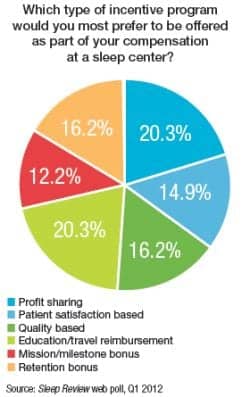
T. “Massey” Arrington, RPSGT, MBA
Despite the current economic situation in the United States causing record unemployment rates, finding—and more importantly—keeping high-quality sleep technologists continues to be a challenge for many employers. Too many times, sleep disorder centers will fail to implement retention strategies to keep their top performers or to attract top performers to apply to their organization. Inevitably, sleep disorder center managers must ask what incentives can be put in place to help keep the techs they want.
There are many types of incentive plans, but nearly all of them include a monetary reward for a desired outcome or result. Bonuses are typically paid out quarterly or annually, and it is important for the organization to properly measure and track this data so these are paid fairly. Creating incentives for fluffy nonmeasurable outcomes such as “improving teamwork” or placing incentive outcomes beyond the reach of the staff can be disastrous. Examples of unattainable goals include implementing a no-show rate that is far above the national average, or rewarding team members for the performance of the entire organization rather than merely the department they operate within. A sleep technologist cannot control an empty med-surg bed or affect the timely discharge of an inpatient; however, they can impact sleep center patient satisfaction scores. Incentive programs should be aligned with organizational goals. For many sleep centers, filling the beds is the wildly important goal, but other factors also can be part of an incentive plan. These often include tracking no-show rates, achieving department-specific patient satisfaction scores, participating in profit sharing, and performing quality sleep studies.
NO-SHOW INCENTIVE

Structuring incentive programs that are based on no-show rates in an accurate and timely manner is imperative. Each month, the technical director or lab manager should have a dashboard of published results, and these incentive plans should be tracked in that fashion. Although large organizations may have someone in the finance department publish this data, it is always recommended that sleep center leadership track this information on their own in the event of any inconsistencies. For example, if tracking no-show rates, be sure to update the data every time there is a no-show in order to keep a rolling running tally. At the end of the month, calculate the total number of scheduled procedures versus a total of actual procedures performed. Let’s say there were 84 studies scheduled, but only 77 studies were performed. The show rate would be 77/84 or 91.6%, so the no-show rate is 100%-91.6% = 8.4%. The incentive might state that this number needs to be below 10% on average for the year, or in many cases must be below 10% for the whole year in order to qualify. Be certain to define the difference, as an average might allow for an isolated bad month, but never going above x% in a given 30-day period might be much more difficult to achieve.
PATIENT SATISFACTION
Patient satisfaction is a popular theme among health care providers; however, often the wrong satisfaction criteria are tracked or, as with many hospital-based programs, sleep centers get lumped in with other outpatient departments and therefore the data are irrelevant. If a sleep center wishes to base an incentive plan on patient satisfaction, be certain information is collected from all patients and the correct questions are asked. What matters to a sleep patient?—Comfort of the bed, interaction with the sleep technologist, timeliness of scheduling, and cleanliness of the facility are all pertinent. Caution should be used if including questions that are vague or too clinical (asking a patient about how much they enjoyed the CPAP mask could be devastating to your scores!). Most facilities provide a questionnaire to the patient the morning after their study or at the time of follow-up. Goals are typically set high, with an average score being tracked for the incentive plan.
PROFIT SHARING
Probably the most common incentive plans implemented by organizations involve profit sharing. These can be tricky, however, and there are hundreds of variations. Most plans will focus on net profit, the revenue after all expenses and taxes are paid—the true bottom line, so to speak. If that is the type being implemented, be sure that the expenses included are reasonable and department specific. For example, one large sleep center chain surveyed included physician bonuses as part of the operating expenses, and there was routinely very little cash left at the end of the month as a net profit to share. Some companies tier the profit sharing with percentages based on amount of net revenue, others pay a flat bonus if benchmarks are achieved, and some even combine these. In rare cases, some companies will pay a percentage of gross profit; as a rule, remember that it is better to receive a smaller cut of gross profit than a larger amount of net profit. In general, a good bonus plan will earn the employee between 3% and 10% of their annual salary assuming targets are hit.
WORK QUALITY
Although more tedious to track, some sleep centers offer incentive plans that focus on the quality of the work performed. Locations often give bonuses for low impedance values, rapid correction of artifact, and properly performed positive airway pressure (CPAP/Bilevel/ASV) studies. These must be quantified and clearly defined with respect to the desired goals. Timely scoring is another often-tracked incentive with bonuses paid out for those technologists who go above and beyond their nightly/weekly/monthly quota. The goal would be to encourage accomplishing extra work, not to punish or overload the staff.
Incentive plans can have a tremendous positive effect on employees and employee morale if implemented correctly, creating a job environment that is focused on quality, improved patient care, positive outcomes, and mutual profit. The organization or employer also benefits as these incentives indicate an improvement in a targeted area or the achievement of a specific targeted goal. In essence, if the organization is improving and profiting above or at a targeted rate, then the employees who assisted in the organization hitting that target also should be rewarded.
DON’T MAKE THESE MISTAKES
If implemented incorrectly, an incentive program can be disastrous. The most common mistakes an organization will make when attempting to implement sleep tech incentive plans include:
- Setting goals to beyond capable or realistic expectations;
- Making the reward too low for the required effort;
- Rewarding poor performers at the same level as high performers; and
- Reducing the base pay and making the bonus an expected part of the salary.
These mistakes can cost a lab high-performing employees or result in mediocre performance across the board.
RETENTION BONUS
Many organizations have implemented retention bonuses paid to sleep technologists who choose to stay for a predetermined contractual amount of time. Similar to a sign-on bonus, these types of cash payouts are defined as a payment or reward outside of an employee’s regular salary that is offered as an incentive to keep a key employee (or employees) on the job during a particularly crucial business cycle or during a high volume period. This is a great method if the lab is expanding, if it is coming into a busy month, or if a competitor is offering a similar incentive. In recent years, retention bonuses have become increasingly popular as sleep technologist poaching has increased, especially in large metropolitan areas. One downside to this type of bonus is that technologists not included will be given a strong incentive to leave.
EDUCATION
Unfortunately, many employers simply cannot afford or do not have the infrastructure to have monetary bonus incentive plans in place. This is often the case with some not-for-profit entities or companies that have little timely cash flow. In these situations, there are other incentives that can be substituted for cash awards such as reimbursement for education or travel to regional meetings that garner much desired education units.
EVERY LITTLE BIT HELPS
Other noncash retention plans can include providing better benefits including paid time off, flexible spending accounts, and better insurance options. Sleep technologists often appreciate “the little things,” and I have routinely found that during lean financial years, providing staff with good coffee, approved space heaters for cold tech rooms, and making sure technologists have all the tools they need to provide clean and artifact-free sleep studies goes a long way toward keeping top performers.
Proper leadership and fair management can go a long way toward retaining good sleep techs as most employees do not leave the company, they leave their direct manager. An unfortunate trend across many hospitals is to consolidate sleep centers under other areas, typically with leaders who have no prior knowledge of sleep center management. If you have a center with high turnover, it helps to evaluate your incentives, but also take a long hard look at the leadership you have in place.
Superior sleep technologists will exhibit a combination of sought after skills that include providing good sleep studies, excellent patient care, and a positive work attitude. Once a lab identifies and hires this type of candidate, it becomes imperative that incentives are provided to keep them. Adapting or modifying an incentive and retention plan to include some of the strategies mentioned above will yield better patient outcomes, reduced turnover, and, more often than not, higher profit.
T. “Massey” Arrington, RPSGT, MBA, is technical director and manager of DeKalb Medical Sleep Disorders Center, Decatur, Ga. The author can be reached at [email protected].



